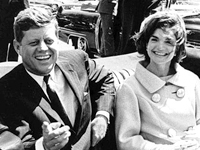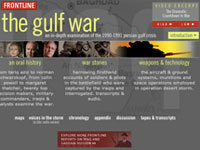Aerial Photography
Tukufu Zuberi of PBS's History Detectives provides a brief overview of the history of aerial photography, particularly its use in reconnaissance.
Tukufu Zuberi of PBS's History Detectives provides a brief overview of the history of aerial photography, particularly its use in reconnaissance.
Professor, geologist, and former astronaut on the Apollo mission Harrison H. Schmitt talks about his experiences as a member of the Apollo mission to the moon, and also discusses the possibilities of mining the moon in future for the energy source helium-3. His presentation includes film footage of the Apollo mission.
At its two locations—the National Mall building and the Steven F. Udvar-Hazy Center in Chantilly, Virginia—the Smithsonian National Air and Space Museum stewards "the largest collection of historic air and spacecraft in the world," according to its website. Through a combination of state-of-the-art exhibits, programs, and media presentations, the Museum interprets aeronautical history for the public.
The museum offers exhibits, self-guided and guided tours for school groups, on-site presentations for school groups, IMAX and planetarium shows, occasional electronic field trips and videoconferences, and on-demand professional development workshops for educators.

This website is devoted to the life, work, and memory of John F. Kennedy, the 35th president of the U.S. Of primary interest to historians and teachers are the "Historical Resources and Education" and "Public Programs" sections of the website, which shed light on important events in early 1960s political history, including the Cuban missile crisis, the Vietnam War, the civil rights movement, the Peace Corps, the space program, and the 1963 Nuclear Test Ban Treaty. Users unfamiliar with the history of the Kennedy White House might begin with the "Timeline," which puts events important to the Kennedy administration in a larger political and cultural context, or "Biographies and Profiles," which presents a Kennedy family tree and profiles of early 1960s notables such as Fidel Castro, Robert McNamara, and Arthur M. Schlesinger, Jr. "White House Diary" further familiarizes users with Kennedy's day-to-day activities as President.
The website also includes hundreds of historical sources including speeches, photographs, telegrams, correspondence, eulogies for Bobby Kennedy, JFK, and Jacqueline Kennedy Onassis (all accessible through an Advanced Search feature), and transcripts of more than 170 oral interviews with notables such as John Kenneth Galbraith (Harvard University economic professor and Ambassador to India), Supreme Court Justice Felix Frankfurter, singer Harry Belafonte, and President Gerald Ford. In some cases, the original audio files of speeches are also included. Several lesson plans designed for elementary, middle, and high school students use materials from this archive to address topics such as Kennedy's inaugural address, the Cuban missile crisis, and the civil rights movement.

Focusing on Operation Desert Storm, these materials emphasize the perspectives of those directly involved. There are 19 oral history interviews (up to 20 pages each) with eight "decision makers," seven commanders, two Iraqi officials, and two news analysts.
"War Stories" presents the personal reminiscences of five pilots, available in text and audio. "Weapons and Technology" details 10 ground, aircraft, and space weapons systems and munitions. A seven-minute video excerpt from the "Frontline" program is available as well as four 15-minute episodes of a BBC radio program in text and audio. The site includes a chronology, 10 maps, a bibliography, facts and statistics, and brief essays on press coverage and Iraqi war deaths. Links are available to five sites produced to accompany more recent "Frontline" reports on Iraq.
From the Smithsonian Air and Space Museum website:
"What is the lasting significance of the Moon landings forty years after they occurred? This session offers an historical perspective on the importance of Project Apollo. It explores key elements of the American memory about Apollo, tackles some of the myths that have emerged, and examines how these myths and memories have affected the course of American society. NASM curator Margaret Weitekamp will discuss commemorative medals and describe their place in recalling the missions. Senior curator Roger Launius will discuss the denials of the Moon landings by a small segment of the population and the evolution of these denials since the 1960s. Finally, curator Allan Needell will offer comments on the physical heritage of Apollo."
From the Smithsonian National Air and Space Museum:
What does the imagery from Apollo tell us? Most people, except for a handful of astronauts, experienced the journey to the Moon through movies and film. Images from the missions have permeated our culture. For example, a rendition of the astronaut saluting the flag was used as a logo for MTV for many years. This session assesses the power of the Apollo imagery in modern society. NASM Senior Curator Roger Launius will discuss the rise of six iconic images and how they have been used over time while Museum Specialist Jennifer Levasseur will explore the fascinating history of the cameras used to capture these images.
From the National Smithsonian Air and Space Museum website:
"How do museum curators determine which artifacts to select for the Smithsonian collections? What can artifacts tell us about history? Join NASM curators Alan Needell, Margaret Weitekamp, and Cathy Lewis as they discuss the significance of several Apollo artifacts, including the Command Module 'Columbia,' spacesuits, and Gene Kranz's vest. Learn the unique stories of each artifact and what they reveal about the larger historical narrative of Cold War America. NASM educators Tim Grove and Mychalene Giampaoli will provide helpful suggestions for teaching with objects in the classroom."
From the Smithsonian National Air and Space Museum website:
"How did the Apollo program intersect with the whirling social and political climate of the 1960s and early 1970s? Three presidential administrations oversaw the Apollo space program, and each reacted in a different way. Senior curator Roger Launius will focus on the myth of presidential leadership during this time period and will provide context to the political challenges NASA faced with the failure of Apollo I. Curators Allan Needell and Margaret Weitekamp will discuss the fascinating intersections of Ralph Abernathy, the Civil Rights Movement, and the Moon landing and will analyze several political cartoons from the period."
From the Smithsonian National Air and Space Museum website:
How did engineers and scientists figure out how to travel safely to the Moon and back? The Apollo missions were a triumph of engineering, with thousands of individuals contributing to the effort. The public often refers to these individuals as 'rocket scientists,' but in fact they were primarily engineers, technicians, and managers. Join two National Air and Space Museum experts as they unravel the technological challenges that NASA faced.
Michael Neufeld and Paul Ceruzzi will explain the complexity behind the Saturn Rocket, the Command, Service, and Lunar Modules and the technique of Lunar-Orbital Rendezvous. Dr. Ceruzzi will also discuss the role of computers—a new technology in the 1960s—as well as the lowly slide rule, used by both engineers on the ground and astronauts in space to assist with their calculations.